|
|
Post by Karl Welteke on Aug 21, 2013 14:41:51 GMT 8
Zossen Communication Bunker -Zeppelin- and -Ranet-. This is the third segment out of four for this day, the 15th April 2013 and this Zossen location. All German communication between all fronts, commands to and from the supreme headquarters in the Third Reich went thru this communication link in WWII. Later the Soviet Armed Forces used it for the same purpose during the Cold War. They gas-proved it and gave it the code name -Ranet-. Here is more to see about the Red Army activity but it is a separate tour and we didn’t have time for that. I took many pictures but I don’t remember which way we went thru this complex. But I consider this an important historical place and uploaded all the 87 pictures into this Flickr set. These many pictures were uploaded only with short titles and tags. They don’t have description but were uploaded in sequence in the order they were shot, so I can follow the way we walked. Here is the album if you are really interested: www.flickr.com/photos/44567569@N00/sets/72157635131923203/Here are 15 sample images and 4 of them are from the www:  Z350-This seems to be voice operations but they also had teletype machines, this is a Wikipedia image.  Z351-Another Wikipedia image about the communication down in the Zossen bunker. 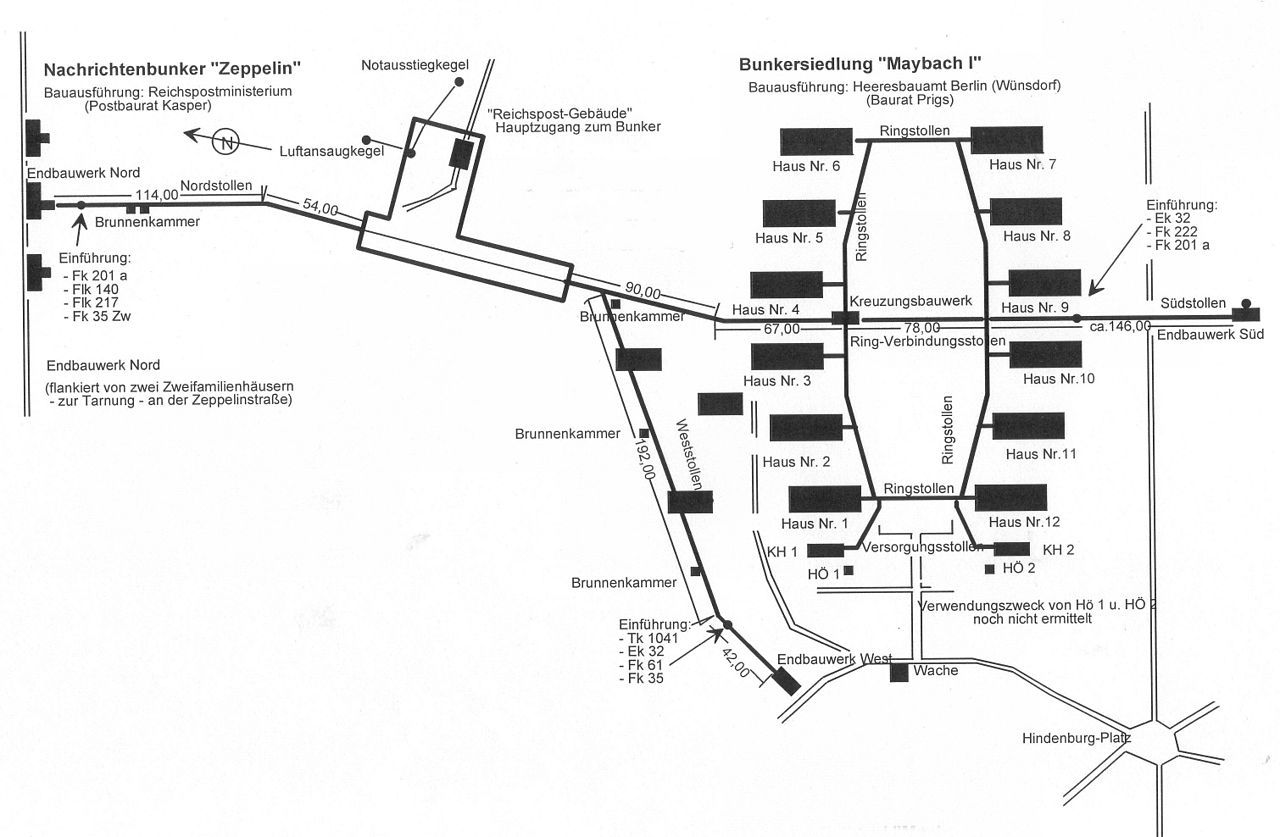 Z352-This great drawing of the Zeppelin bunker complex is from Wikipedia and came original from Hans George Kampe who wrote the book-The Underground Military Command Bunkers of Zossen, Germany.  Z353-This is how the north entrance to the Zossen bunker was camouflaged with a civilian residence looking house.  Z354-This is how it looked at places in the Zossen tunnel complex. Except for the four pictures from the www, any old picture was displayed and I shot a copy like this one.  Z355-The communication bunker run out of men, they were needed on the front, the women took over. They were quartered just north of the Maybach I buildings, look at the map on this picture.  Z356-The camouflaged entrance we used and we just came from walking thru the Maybach I complex. That tower has something to do with ventilation.  Z357-I did not shoot this picture it came from Wikipedia. Compare it with the last image, both are showing the Zossen bunker entrance, it looks like some trees got cut.  Z358-The entrance door to the Zossen bunker is a Red Army addition, during the Cold War they also were ready for nukes.  Z359-This map, drawing was posted down on the wall and I photographed it.  Z360-The Zossen bunker has apparently two levels, but as of now I can not tell which of my pictures are from which level.  Z361-Here we seem to go down from one level to the next.  Z362-These bunks must have been used by the Red Army, I think the Germans run three 12 hour shifts with three sections and marched to the barracks back and forth. I believe the US only bombed this place three times and that was in 1945.  Z363-There was at least one place where the Red Army did some blasting in the tunnel complex, in the communication bunker or near by, I could not tell.  Z364- We are done and just stepped out of this building. It is April, the people have jackets on and only the needle wood trees are green. |
|
|
|
Post by Karl Welteke on Aug 23, 2013 16:21:19 GMT 8
Bomb-Shelter-Towers in Zossen and Wuensdorf, 2013-04-15 This is the 4th of four segments in Zossen, the supreme HQ of the German Army and Wehrmacht and later the Soviet Union at its West Front during the Cold War. This is the end of the 7th day into the history of the Third Reich. TOMORROW IT WILL THE COLDITZ CASTLE!!!! One more thing of Third Reich history I didn’t know of and it is an oddity to most, and it remains here in the Zossen Stammlager. There were 19 of these unique aircraft shelters or bomb shelters. Most of these were destroyed by the Red Army but a few still stand in the ex Zossen Stammlager, the Waldstadt now and the ex Wuensdorf Garrison. We only visited #13 which was near the Garrison Museum and here are the 38 images. www.flickr.com/photos/44567569@N00/sets/72157635197046530/All written material is in German and you may want to skip the album because of it and just look at the sample pictures here in this thread. Wikipedia says this about these Hochbunker (high bunker) or Winkelturme (Winkel-name of designer; Turm-tower) in one of the segments in this URL. en.wikipedia.org/wiki/Air-raid_shelterOne particular variant of the Hochbunker was the Winkeltürme, named after its designer, Leo Winkel of Duisburg. Winkel patented his design in 1934, and from 1936 on, Germany built 98 Winkeltürme of five different types. The towers had a conical shape with walls that curved downward to a reinforced base. The dimensions of the towers varied. Diameters ranged between 8.4 and 10 meters and the height between 20 and 25 meters. The walls of the towers had a minimum thickness for reinforced concrete of 0.8m and 1.5 meters for ordinary concrete. The towers were able to shelter between 164 and 500 people, depending on the type. The intent with the Winkeltürme and the other hochbunkers was to protect workers in rail yards and industrial areas. Because of their shape, the towers became known colloquially as "cigar stubs" or "sugar beets". The theory was that the curved walls would deflect any bomb hitting the tower, directing it down towards the base. The towers had a small footprint, which was probably a greater protection. A US bomb did hit one tower in Bremen in October 1944; the bomb exploded through the roof, killing five people inside. This web page says the following: en.tracesofwar.com/article/4953/Air-Raid-Shelter-W%FCnsdorf.htmThis air raid shelter (in German: Hochbunker) is of the Winkel-type. Up to about 600 employees could find shelter during bombardments. Most bunkers of this type were built around 1936 on industrial sites. The steep roof ensured that bombs did not explode on the roof. About 200 bunkers of this type were built. Text: Fedor de Vries Here are some sample images:  Z388-This one of the 7 remaining Bomb-Shelters at Zossen & Wuensdorf and it is from Wikipedia Commons.  Z389-Bomb-Shelter #13, the one we visited and which was near the Garrison Museum.  Z390-A nice clear image from Google Earth showing # 13 and # 12 Bomb-Shelter in the ex Zossen-Stammlager which is now called the Waldstadt, City in the Woods.  Z391-, Sorry for this not to clear picture but it shows the location of the 19 Bomb-Shelters in the ex Zossen Stammlager (left) and the ex Wuensdorf Garrison (right).  Z392-In 1997 was one more demolition, because one tower was only partially blown by the Red Army and was considered a hazard the new United Germany finished the job.  Z393-A more detailed plan of one type of Bomb-Shelter.  Z394-The pointed peak of one of the 12 destroyed Bomb-Shelters.  Z395-The foundation of #16 Bomb-Shelter blown out of the ground. All these pictures were displayed either in the Bomb-Shelter #13 or in the Garrison Museum.  Z396-This is a little different type Bomb-Shelter pictured here and it is/was at the Potsdam Wildpark.  Z397-Entrance to Bomb-Shelter #13 at ex Zossen Stammlager. It is the one we visited.  Z398-Another nice and clear Google Earth image of the ex Zossen Stammlager, now Waldstadt showing two more Bomb-Shelters which I believe are the numbers 1 and 2. 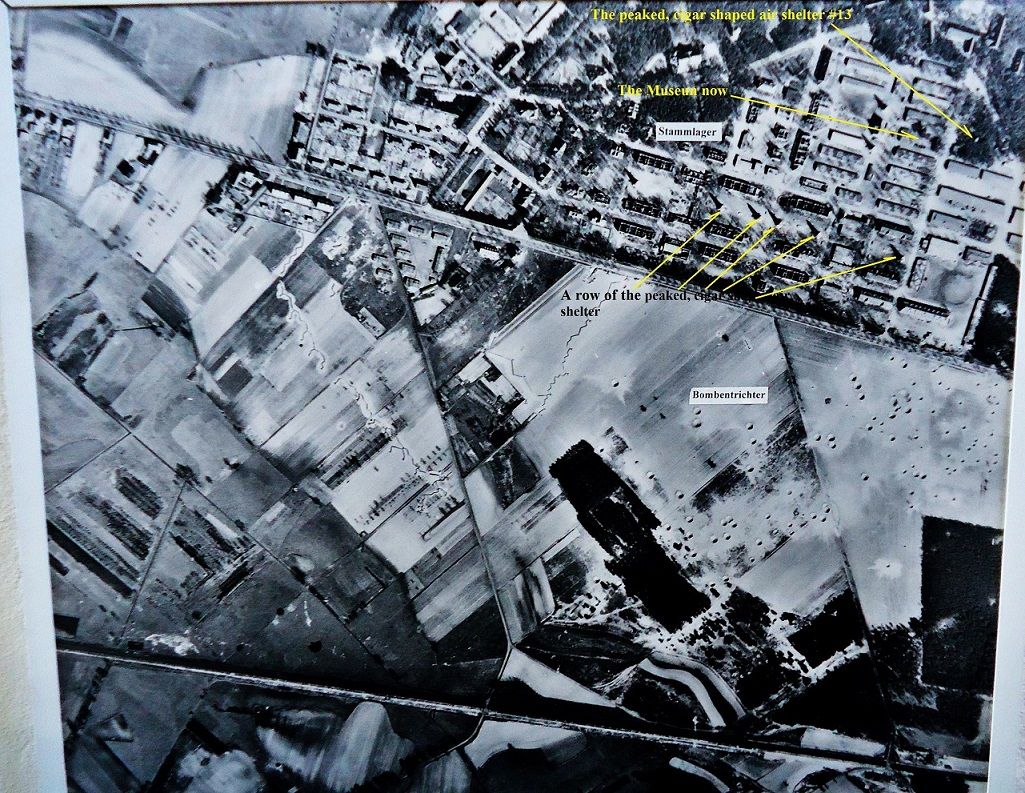 Z399-The US Army Air Corps came visiting in March 1945, they hit some structures and missed many. But on this picture I marked 6 Bomb-Shelters in the ex Zossen Stammlager are and now I see two more. |
|
|
|
Post by Karl Welteke on Aug 25, 2013 20:22:26 GMT 8
Battle of the Nations Monument, the Voelkerschlachtdenkmal We are on our 8th day into the history of the Third Reich. At the home of my cousin in Leibzig we were treated royally and on this morning we continued to the Colditz Castle but we stopped at the Battle of the Nations Monument, the Voelkerschlachtdenkmal first. This is the 2nd time I had the opportunity to visit and reflect what this monument means to me. It is in Leipzig and the Victory in this battle meant Freedom, the birth of the Iron Cross and the beginning of the unity of Germany towards the 2nd Reich. Here is my album of my first visit in 2010. I notice now one picture has been eliminated by Photobucket management. I don’t remember which one but it may be the one with Hitler. s74.photobucket.com/user/PI-Sailor/library/Family/Germany-Poland%20Visit%202010/Leipzig%202010%20Nov%204th%20to%205th/Battle%20of%20the%20Nation%20Monument?sort=3&page=1Wikipedia says this about the Battle: Between 16–19 October 1813, the Battle of the Nations was fought by the coalition armies of Russia, Prussia, Austria and Sweden against the French army of Napoleon aided by Polish and Italian troops as well as German-speakers from the Confederation of the Rhine. Napoleon's army was defeated and compelled to return to France while the Allies invaded France early the next year. Napoleon was forced to abdicate, and was exiled to Elba that spring. Here are sample picture all but one are from the www:  Z400-My view of the Battle of the Nations Monument, the Voelkerschlachtdenkmal on the 16th April 2013.  Z401-That is the best view of the Battle of the Nations Monument, the Voelkerschlachtdenkmal I seen so far and the source is indicated on the picture.  Z402-The inside view of the Battle of the Nations Monument, the Voelkerschlachtdenkmal and it is also the best I seen so far. The source of the picture is indicated.  Z403-This battle, this struggle was also the birthplace of the German Iron Cross and really the start to reunification of a modern Germany, the Second Reich in 1971. I tried to find the reason for the word iron in the medal name but failed. I do remember that my history teacher said it was for “I gave Gold for Iron” in the struggle to free Europe from Napoleon but did not find that in writing.  Z404-A commemoration demonstration at the Battle of the Nations Monument, the Voelkerschlachtdenkmal 25th May 1924 to protest the occupation of France in that region (that is what I assume). This picture is from Wikipedia. 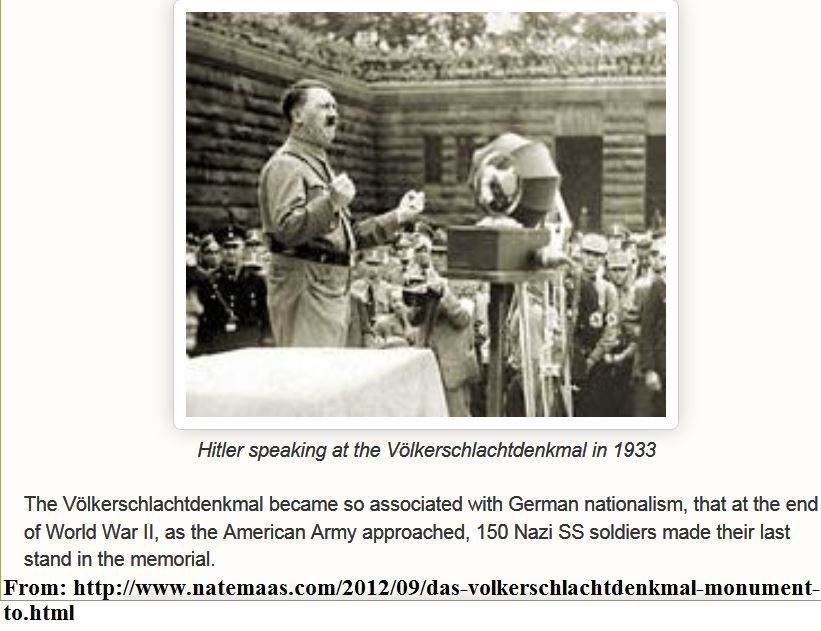 Z405-The writing on this picture explain how the monument was used by the National Socialists (Nazis) and where the picture came from.  Z406-I think this picture is a jewel and on it is written where it came from and it really is symbolic to the end of the Third Reich.I guess I was not the first American to visit after the war, he, he. Note: There is much written in the www about this place and its history if you are interested. |
|
|
|
Post by Karl Welteke on Aug 26, 2013 14:29:22 GMT 8
COLDITZ CASTLE, THE POW BREAKOUT CENTER IN WWII On our 8th day into the history of the Third Reich and we are heading to one of our main goals, the Colditz Castle. This is album 1 of 2, pictures were shot on the 16th April 2013. This album is mostly on the outside of the castle or in the courtyards. Here is the album with 20 images: www.flickr.com/photos/44567569@N00/sets/72157635238369076/There is large amount of information on the www in regards the POW escapes from the Colditz Castle, so help yourself! Here are some sample pictures from mine, my partner Steve’s album and one aerial image from the www:  Z407-After we parked in Colditz town, we walked up to the castle, keeping to the right and went by the church at right.  Z408-The aerial image from the www, the source is indicated.  Z409-A map to give you an idea where Colditz is.  Z410-Inside the German section of the Colditz castle. 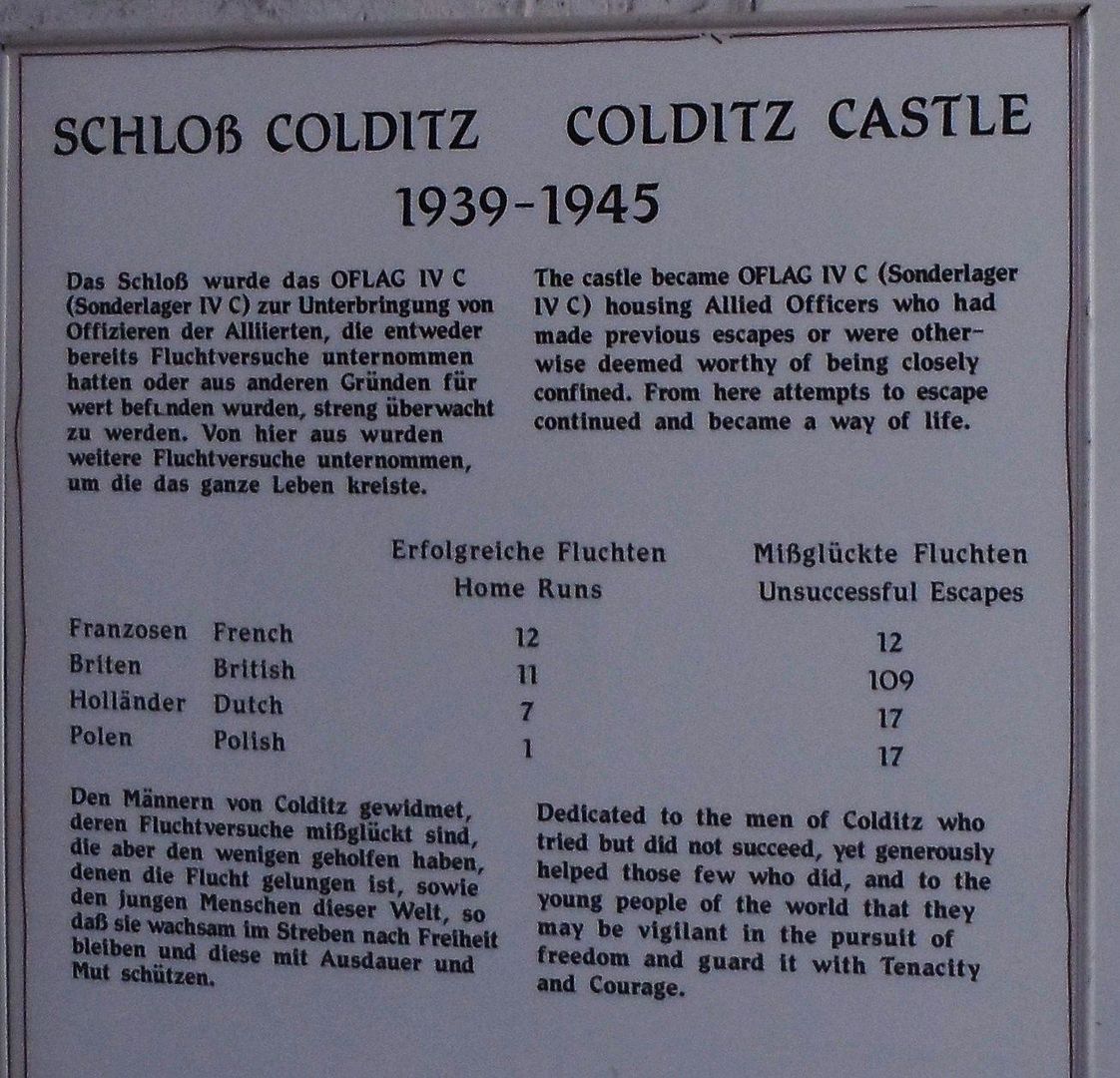 Z411-The statistics of the escapes, successful and not.  Z412-This commemoration plaques remembers the actions of another dictatorial regime, the communists. The commies did not waste any time, in autumn 1945 they rounded up all the nobleman and anyone who owned a lot of land, incarcerated them here in this castle for a long time and took away their processions for good.  Z413-Somewhere on this park route is this Polish Commemoration plaque remembering the Poles. It says, there were at least 10 Generals here and many other high ranking officer from the 1939 battle and also included were the Commander and other officer who led the Polish Warsaw uprising in 1944. 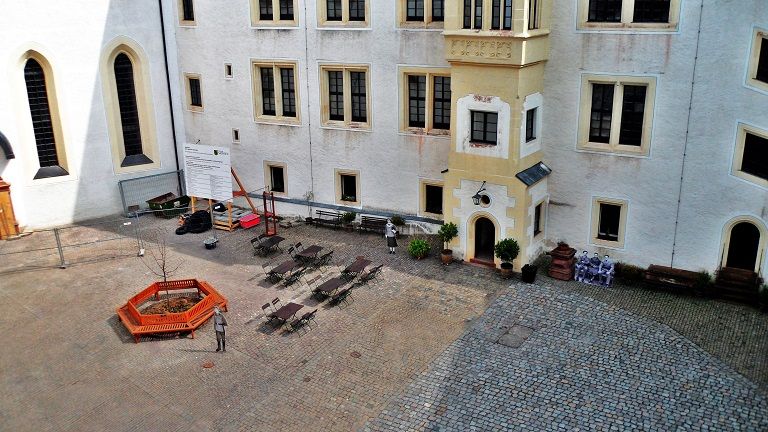 Z414-This is the POW courtyard, to small for sufficient exercise and that is why the prisoners were taken to the park for that purpose. In the war the Germans took pictures of all the POWs who got caught escaping and now the POW museum uses those photo cut-outs and placed them here. This picture is from my partner Steve’s collection.  Z414-This picture is from my partner Steve’s collection. This used to be a deeper manhole in the park and Dutch POW hid here during the exercise. It was covered and at night he opened it and made his way out and over a park wall.  Z416-Colditz town from the castle, another Steve image. |
|
|
|
Post by Karl Welteke on Aug 28, 2013 11:22:31 GMT 8
COLDITZ CASTLE, THE POW BREAKOUT CENTER IN WWII On our 8th day into the history of the Third Reich and we are heading to one of our main goals, the Colditz Castle. This is album 2 of 2, pictures were shot on the 16th April 2013. This album is mostly about the displays inside of the castle or in the courtyards. Most of the pictures are not very good, just holding the camera does not work for good shooting, items like this. Here is the album with 18 images: www.flickr.com/photos/44567569@N00/sets/72157635254703368/There is large amount of information on the www in regards the POW escapes from the Colditz Castle, so help yourself! Here are a few sample pictures:  Z417-A German photographer was tasked to shoot images of all escaped prisoners that got caught and their means of escaping to train the prison staff. That is how these photo cut-outs got posted in the POW court yard.  Z418-This is the exit of the famous French Tunnel which got discovered and did not succeed. This tunnel exit only got discovered in recent years.  Z419-The display of the famous French Tunnel.  Z420-In 1943 the Belgians and French were transferred in 1943, a prominent civilian prisoner, Romilly, hid in a box. At the Colditz railway station the boxes were weight and his box got turned around and he ended up in an extreme difficult physical position and climbed out, that was the end of this escape try. |
|
|
|
Post by Karl Welteke on Aug 31, 2013 20:57:02 GMT 8
WEWELSBURG 2013-04-17, HIMMLER’S PET PROJECT Wewelsburg, I had heard of it and it always was described as a crazy project of Himmler. Indeed it was his project but nothing came of it and then he ordered it destroyed. It has been rebuilt and is now a Youth-Hostel, a museum and commemoration place documenting and remembering the inhuman Nazi (NS) regime. Over 1200 KZ prisoners died here in the hands of the NS Regime! We are on our 9th day into the history of the Third Reich and I put my 30 images into this Album: www.flickr.com/photos/44567569@N00/sets/72157635314233692/Wikipedia says this about Wewelsburg: Wewelsburg is a Renaissance castle located in the northeast of North Rhine-Westphalia, Germany, in the village of Wewelsburg, which is in the district of Paderborn in the Alme River Valley. The castle has the outline of a triangle. After 1934, it was used by the SS under Heinrich Himmler and was to be expanded to the central SS-cult-site. After 1941, plans were developed to enlarge it to the so-called "Center of the World". In 1950 the castle was reopened as a museum and youth hostel. The museum's contemporary history department was reopened as "Wewelsburg 1933–1945 Memorial Museum" in 2010. The youth hostel, which is mainly placed in the east wing of the castle, is one of the largest in Germany. Here are 13 sample images incl. 3 are from the www:  Z464-Post WWII Wewelsburg from David Crossland via the German News Magazine Spiegel.  Z465-A photo copy of a display in the castle or museum showing the whole commemoration place Wewelsburg.  Z466-Himmler picked a castle in the middle of Germany, where is Wewelsburg, about in the middle of Germany, this is a historic area for me. Karl the Great fought many battles here Christianizing the Saxons at the turn of the 8th century and even more historic, in the year 9 after Christ the Germans destroyed three Roman Legions in this general area and the Romans never came back. See the Hermannsdenkmal on this map for this occasion.  Z467-We arrived at the former SS gate sentry post for the Wewelsburg.  Z468-The same sentry post from some distance, note the plaque (commemorating the 1250+ victims of the Niederhagen Concentration Camp, KZ who died or were executed here at this Himmler castle project. The door at right goes to a restaurant now.  Z469-The south side and the south-wing of Wewelsburg. This ditch was deepened to make appear like a moat. 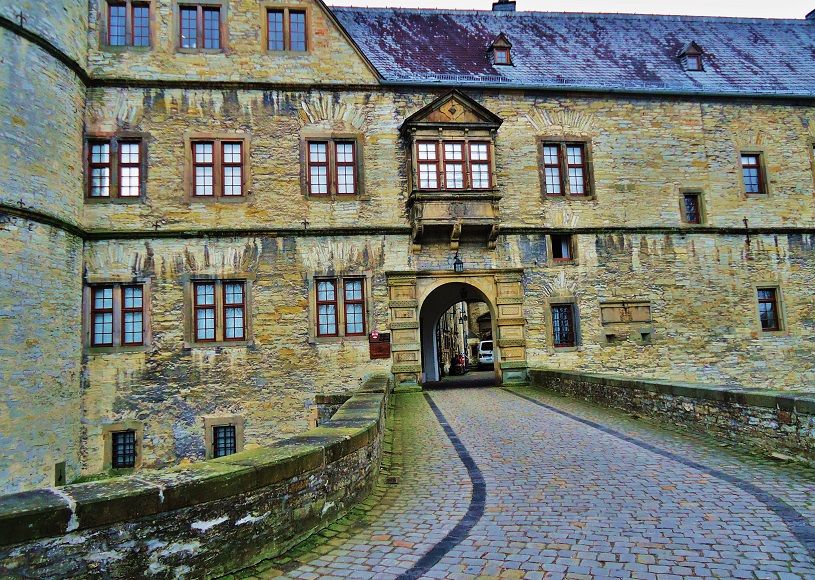 Z470-The main entrance to the Wewelsburg going over a bridge and thru the East-Wing.  Z471-The North-Tower of the Wewelsburg, one can clearly see how the west-wing and the east-wing, right merge with the North-Tower.  Z472-Looking to the south and the south-wing which is the local history museum, right, the west-wing is the youth-Hostel. I don’t know what the left wing, the east wing, is used for.  Z473-The 1934 rebuilt Wewelsburg entrance bridge on the east-wing. An formation sign for the main bridge reconstruction says, Himmler ordered it rebuilt wider for vehicles. Until the establishment of the concentration camp (KZ) Niederhagen in 1940 most work was done by the German Arbeitsdienst.  Z474-This space in the North-Tower is called the crypt! In the North-Tower taking pictures was restricted and I followed the rules (I guess I’m still a German in that department). This image is from David Crossland via the German News Magazine Spiegel and it tries to explain what Himmler may have had in mind. This space was not open to be visited!  Z475-Into this space we were able to go but no picture taking was allowed. This image is from David Crossland via the German News Magazine Spiegel. In my opinion is, it was Himmler’s pet-project and most people, including his senior followers thought of it as a crazy idea.  Z476-Again a bad picture but it shows how the castle looked like after it was blown and burned on Himmler’s orders and the SS man who did it. This was just before the NS regime finally collapsed. |
|
|
|
Post by Karl Welteke on Sept 2, 2013 21:17:24 GMT 8
NIEDERHAGEN KZ, WEWELSBURG TOWN 2013-04-17 Coming here to Wewelsburg, we not only wanted to look at the castle but also look at what is left of the Niederhagen Concentration Camp (KZ) and get a view of the town. Over 1200 KZ prisoners died here in the hands of the NS Regime! 29 images are uploaded into this album/set: www.flickr.com/photos/44567569@N00/sets/72157635339954115/Wikipedia says the following about Niederhagen Concentration Camp (KZ), here is the URL: en.wikipedia.org/wiki/Niederhagen_concentration_campFrom May 1939, a small camp, the Wewelsburg satellite camp of Sachsenhausen KZ, existed on the site. The inmates were used as slave laborers for the development of Wewelsburg Castle, which - according to Himmler's plans - was to be the "center of the world" after the "Final Victory". The first 100 prisoners came from the Sachsenhausen KZ. At first the inmates were housed in a tent at the foot of the hill on which the castle stands, later in huts on the hill opposite Wewelsburg castle(the Kuhkampsberg). A move to a newly-built camp in the Niederhagen suburb of Wewelsburg followed. In September 1941, when the camp became an independent concentration camp under the name Niederhagen concentration camp, 480 prisoners were interned there. From 1941, more and more prisoners from outside Germany were imprisoned in the camp. Of the approximately 3,900 prisoners, almost a third of them did not survive their imprisonment. The deaths of 1,285 prisoners are recorded. They died of hunger, cold, disease and the consequences of ill-treatment. Very little is left of the camp. Today, the former camp kitchen houses the local fire station of the volunteer fire department and some apartments, the gatehouse is now a two-family house, while a residential estate was built over the rest of the former camp. Here are 9 sample images:  Z477-This is the Commemoration place to the Niederhagen Concentration Camp (KZ). The writing on it says -it is a triangle in reference that all prisoners had to wear a triangle symbol to indicate what kind of prisoner he or she was. The wreath said to remember the 2nd of April, I believe that was the day of liberation when American GIs arrived.  Z478-This is one of two buildings left from the former Niederhagen KZ. It is now used by the Volunteer Fire Service. The other one is the former gate building, we did not look for it.  Z479-Maybe a WWII Allied image of Wewelsburg, town and Niederhagen KZ. 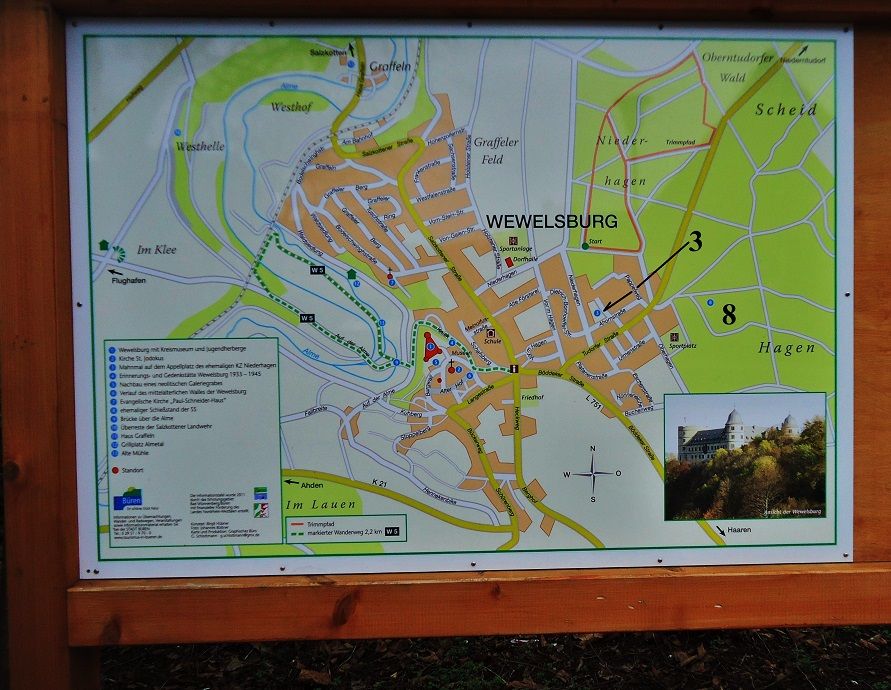 Z480-On this map one can read Niederhagen, that is where the Niederhagen KZ was. I increased the size of numbers eight and three. Number Eight was here the SS shooting range was where KZ prisoners were executed by the SS, more later about that. Number Three is were the Niederhagen KZ Commemoration place is, shown in front of this album/set.  Z481-The history of the Niederhagen KZ, 1939-1945, about 3900 prisoners went thru here, 1285 are known to have died here or were executed, murdered.  Z482-The make-up of the prisoners. The Wikipedia URL above has a more detailed break down.  Z483-It says, sometime we were forced to stand in 20 degrees Celsius freezing with only this clothing and the wind was going thru these clothing. We all tried to get in the middle, like a herd of sheep.  Z484-In the year 2000, the 55th anniversary of the liberation these former prisoners returned and these pictures were taken of them..  Z485-This picture shows Oswald Pohl the chief of the economy branch of the SS in his Nuernberg Trial, he was executed. All KZ camps were used by the SS to make money and he was in charge of that. |
|
|
|
Post by Karl Welteke on Sept 8, 2013 11:58:23 GMT 8
WEWELSBURG AND HISTORY On our 9th day into the history of the Third Reich and so far I presented two segments, the Wewelsburg Castle, Himmler’s pet project, and the Niederhagen Concentration Camp (KZ). There was more to see and we spend the whole day here. I made two more albums, for my purpose only, and will not share them because they are too hard to present. In the south-wing of the castle has been established the “Historical Museum of the Prince Bishopric of Paderborn”. I have over 100 pictures and it is my history. My grandfather, paternal side, came from not too far from here, the area of Waldeck. Did my family name came from that word, all Weltekes came from Waldeck. This area is in the heart of Germany, this is where the Germans destroyed 3 Roman legions in year 9 after Christ and the Romans never came back. The Germans rather destroyed the Roman empire and adopted it as theirs. The museum tells how Christianity came here and spread east and north from here and was the foundation of the First German Reich 800-1805. It tells how the age of Napoleon reduced the power of the church at the turn of the 18th century. How all of Central Europe fared under the Thirty Year War 1616-48 and the Seven Year War 1756-63 The other album is also over 100 images and I will not bore you, much of the material is in German: It is the WEWELSBURG 1933-45 MEMORIAL MUSEUM. It is all about the SS Terror, it’s organization and its inhumanity. And it also present the special relation ship this town Wewelsburg had with the SS and Himmler in particular. Not by choice of course and how it had to deal with it during and after the fall of the NS Regime. If anyone is interested the Museum authorities have this presentation in English: If you open this URL you will see the web page, presented in two pictures below it: www.wewelsburg.de/en/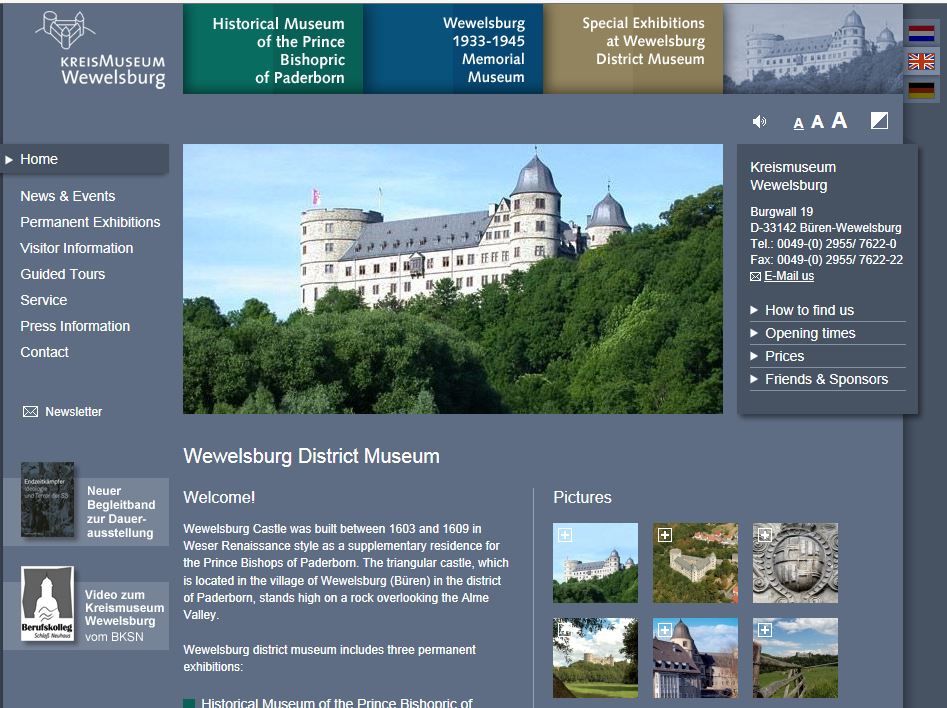   The 1933-to 1945 SS Museum is located in this former SS castle guard detail building. This building has 4 levels so a lot of material is offered!  The Historical Museum of the Prince Bishopric of Paderborn is located in the south-wing of the castle. The south wing is in front of this picture, this image is from a time long ago. |
|
|
|
Post by Karl Welteke on Sept 10, 2013 17:09:14 GMT 8
SUBMARINE BUNKER VALENTIN & BAHRSPLATE KZ We are on our 10th day and the 2nd last one into the history of the Third Reich We started out with the Submarine Bunker Valentin in the outskirts of Bremen. We did not have an appointment and just walked around the huge bunker. The end of the war and British bombs prevented it from being used. Countless KZ prisoners and forced laborers died here at the project and we visited only one of several KZ camps for this project. I have uploaded 27 images into this album: www.flickr.com/photos/44567569@N00/sets/72157635465287428/My thoughts: An impressive construction, but all was a waste, worse was the inhumanity. And this grand idea of Admiral Doenitz did not work out, it was too late and Allied bombs halted it anyway. And the Atomic bomb was waiting to be finished for Germany and thankfully, Germany collapsed before its use. Admiral Doenitz had said that for this priority project no sacrifice should be spared. He visited this site at least ones and I am sure he had no eyes or thoughts about the inhumanity around him! Here are 8 sample images from my album and 7 images from the www.  Z518-The final launching slip at the NW end of the Valentin Submarine bunker in Farge, Bremen. 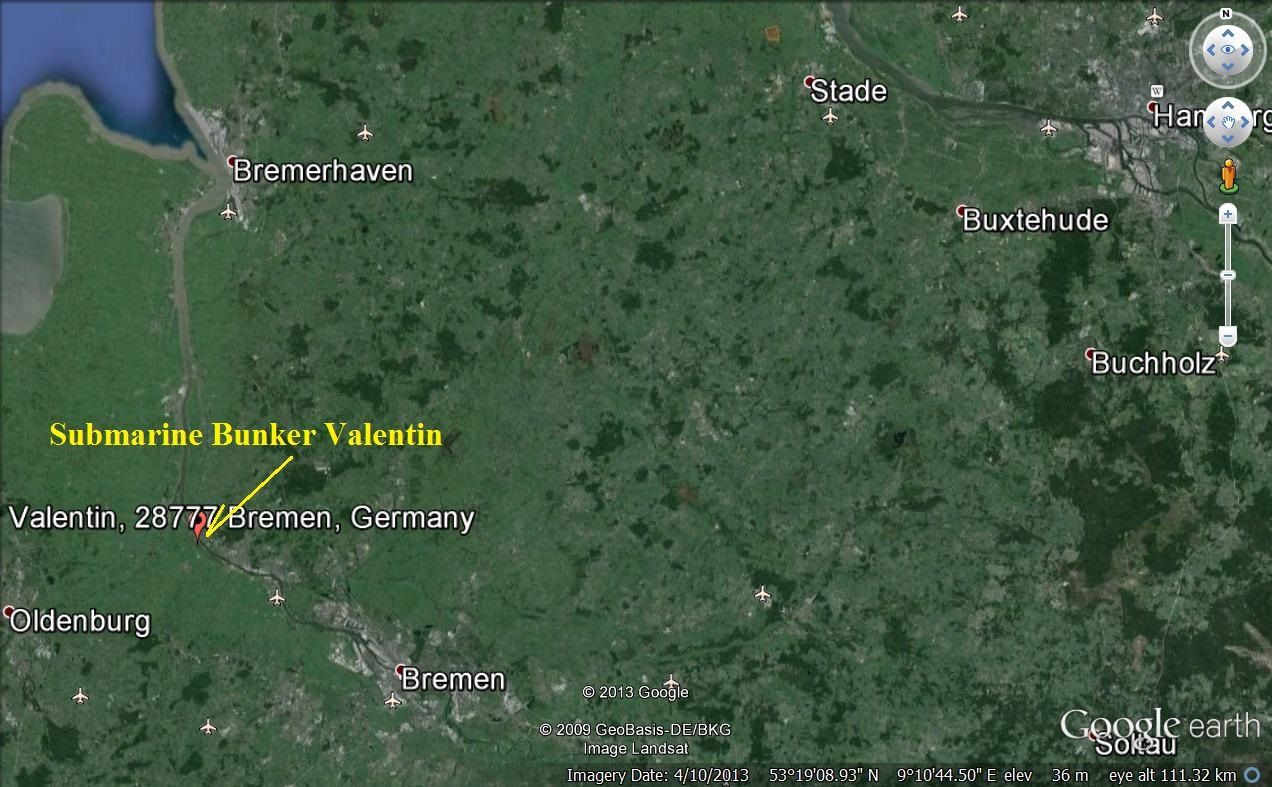 Z519-The location of the Valentin Submarine Bunker, we had landed in Hamburg and used Stade as our base of operation.  Z520-The SW side of the Valentin Submarine Bunker from the SE end. We decided to walk around the complex counter clock-wise. We started on the other end, the NW end and have reached this SE end.  Z521-A memorial to the Nazi victims has been erected here on the SE end in 1983.  Z522-Around the Valentin Bunker complex are several information signs and I shot this image of the bunker construction. The sign said the bunker was started mid 1943 and that the Allies already had control of the skies. Doenitz said for this priority project no scarifies should be spared. The bunker was constructed in 20 month with about 10,000 forced laborers doing the heavy work in 12 hour shifts. The food was inadequate and the quarters were inhumane and so about 2000 people died with 1,144 names being documented.  Z523-On this sign, a French forced laborer said “ We worked under most difficult conditions and our quarters were places of total inhumanity, and logically many people died”. At the end of March 1945 British Bombs damaged the almost finished bunker. Shortly there after all work stopped. It was used as a bombing target by the Allied after the war, then children used it as adventure place. At the end of the 50s the German Military used it for various purpose until 2010.  Z524-These curved spans were used in the construction of the Valentin Bunker. Do not know how. Wikipedia image from the German Federal Gov.  Z525-Forced laborers and KZ prisoners at the Valentin Bunker. Wikipedia image from the German Federal Gov.  Z526-Forced laborers and KZ prisoners at the Valentin Bunker. This image is from Valentin Bunker Commemoration site.  Z527-Bomb damage on the Valentin Bunker, this one may have occurred during the post war bombing experiments by British and US Forces. Wikipedia image from the German Federal Gov.  Z528-The Valentin Bunker 1951. This image is from Valentin Bunker Commemoration site.  Z529-This must be a very recent image of the Valentin Bunker, half of it is covered by solar panels. Steve seemed to be surprised about the many solar panels we seen in Germany on this trip (in this cold weather with little sun). I told him, in view that Germany has no oil, every KW electricity is a Euro saved and produces jobs for panels, installations and maintenance. Also Germany is dismantling their nuclear power plants! This is a Wikipedia image.  Z530-From inside the Valentin Bunker looking out across the submarine launching slip. This image is from the Friedensschule, it is the organization that runs the tours and takes care of the place as a commemoration place.  Z531-We drove around and ended up at this park which turned out to be one of many the forced laborers and concentration sub camp sites. This Bahrsplate it had both kind of camps. 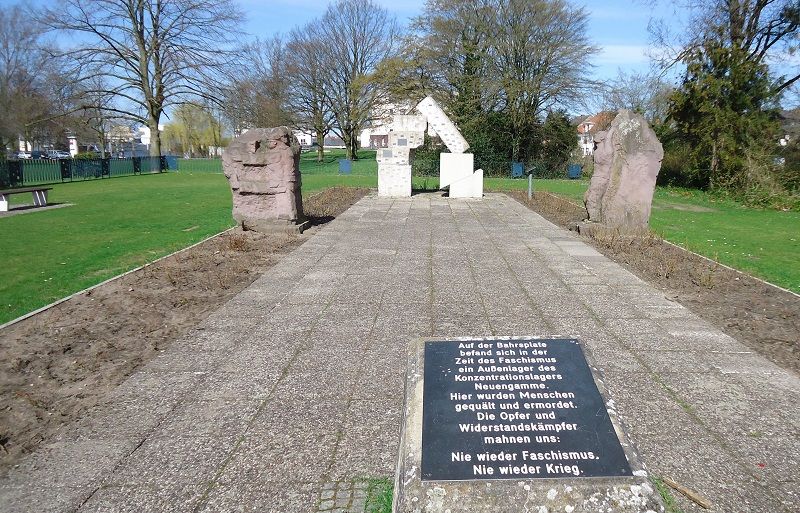 Z532-The Bahrsplate memorial, in the album above are more pictures about this site. |
|
|
|
Post by Karl Welteke on Sept 14, 2013 13:01:09 GMT 8
FALLINGBOSTEL POW STALAG XIB CAMP MEMORIAL AND MILITARY MUSEUM 2013-04-18 This is our 2nd stop on our 10th day into the history of the Third Reich. This area was the Truppenuebungsplatz (Training Center) Bergen for two German Army Division. When the war started this STALAG XIB (POW Camp) was established here. The British Army took over and until today still has units stationed here. Between the British Army and the local community a Memorial to the STALAG was established and a retired British Soldier runs a Military Museum here. We visited and here are the pictures. 100,000 POWs were registered here but most were in hundreds of work details on farms or other commercial places for work etc. However one very sad fact is that about 30,000 Soviet POWs died here. More of these POWs in the next segment. 23 images were uploaded into this album/set: www.flickr.com/photos/44567569@N00/sets/72157635487712727/Here are 15 sample pictures but 9 of them came from the www:  Z542-The Fallingbostel STALAG XIB Memorial, it is not far from the Military Museum. Note that the Memorial is in a form of a gate!  Z543-I am not sure but the reason the Memorial is shaped like a gate is maybe because of this famous picture. This was the moment the British Army arrived in 1945 and liberated the camp. A combat photographers was along and shot this memorable image. Obviously this is a capture shot from a video about an ex British POW soldier returning for a visit.  Z544-This is how the entrance to POW camp looked, this picture is from the German STALAG XIB Memorial (Gedenkstaette) web page. 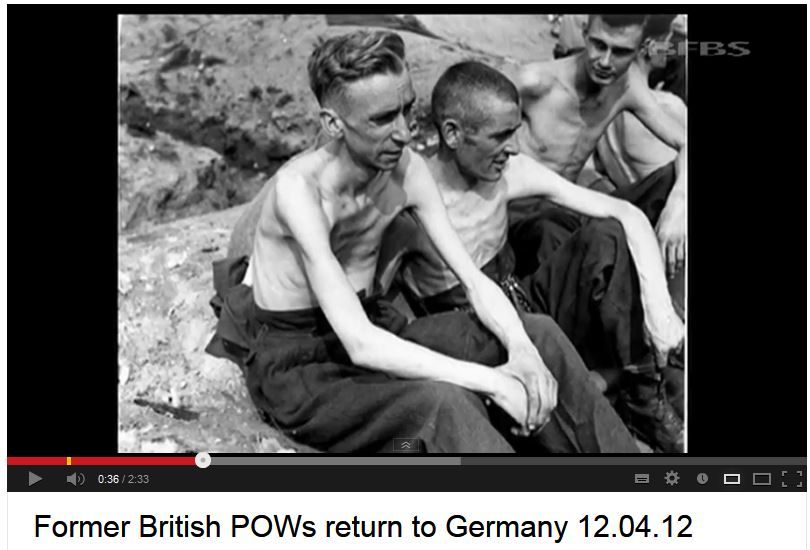 Z545-This captured image is from a video, the URL is at the end of this segment. These liberated Allied POWs may from another location.  Z546-This is a captured image from the same video, it was in April so they, the former POWs, probably returned on the anniversary of their liberation.  Z547- The former POWs approach the Memorial to lay a wreath. This is a captured image from the same video, the URL is at the end of this segment.  Z548-The former POW visitors, dignitaries and soldiers formed up for an official picture at the STALAG XIB POW Camp Memorial.  Z549-This was a British Army show, there is a large armored unit based here in Fallingbostel, but the Museum curator said they are scheduled to leave in a few years. 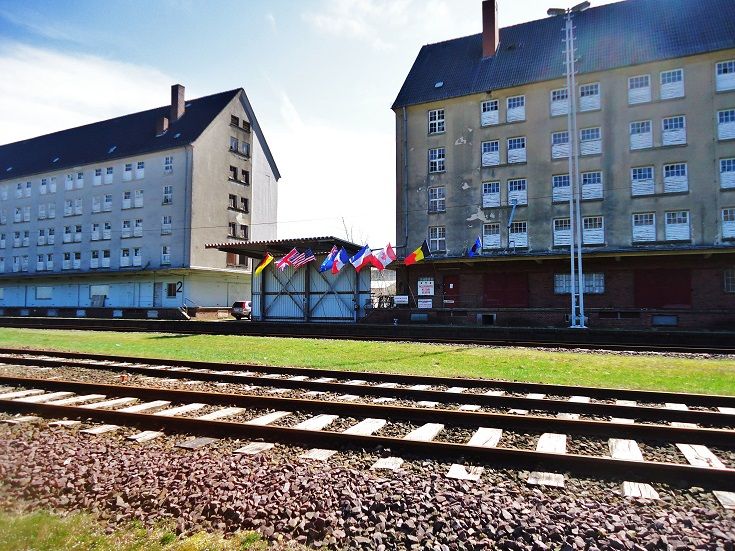 Z550-We arrived at the Fallingbostel Military Museum, it occupies the ground floor of the building at right. This is a row of 3 large warehouses next to freight rail loading station. My guess the Wehrmacht and now the British Army loaded their tanks here.  Z551-This picture is of Kevin Greenhalgh (a retired British Soldier) and his son an active German Soldier. They are the Curators of this museum. The museum used to be on the British Base but just this month of April 2013 they are in the process of moving and setting everything up at this new location.  Z552-The location map of Fallingbostel, it is located in Lower Saxony. I grew up near Hamburg along the river Elbe so in a way this is my neighborhood. But because at that time we never had the chance to travel much and I never got here, not even close.  Z553-The landmarks for this segment and my album.  Z554-Several sections of the museum are dedicated to the POWs. He had many ex POWs come visit in the past. As I said before he was in the process of moving and setting up the museum in this new location.  Z555-This is way the Kevin is laying out the museum in this new location. It is also amazing as to the many weapons and other equipment he was able to collect for the museum.  Z556-This is another POW section and here people can watch videos. Kevin and his son are running this museum pretty much on their own and it is amazing how much stuff the collected over the years. Thank you very much Kevin. Mabuhay and Aloha from Karl in the Philippines. Several of the pictures in this segment have been captured from this video: |
|










































































































